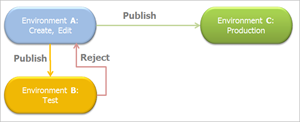One way synchronization scenarios
Following are three scenarios when you can use Syncing of published data:
Scenario 1: Two environments
You have the following environments:
A: Work.
B: Production.
- Content creators create and edit content on A.
- Content managers or approvers sync the content to B.
Content is published with a publication and expiration date.
The following flowchart depicts the scenario:

Scenario 2: Three environments
You have the following environments:
A: Work.
B: Staging
C: Production.
- Content creators create and edit content on A.
- After the work on A is completed, content creators or approvers sync the content to staging environment B.
- QAs, content approvers, or managers proofread and test the content on B.
- If everything is OK, content is synced from A to C.
- If problems are found, corrections are done on A and content is synced from A to C.
NOTE: Syncing the content from A to C, guaranties full synchronization.
The following flowchart depicts the scenario:

Scenario 3: Three environments - Cascading Syncing
This scenario is used on websites with high flow of published data, like big news websites, where the time for editing and proofreading is limited and content creators work constantly to create new content.
You have the following environments:
A: Work.
B: Staging.
C: Production.
- Content creators create and edit content on A.
- After the work on A is completed, content creators or approvers sync the content to staging environment B.
- QAs, content approvers, or managers proofread and test the content on B.
- If everything is OK, content is synced from B to C.
- If problems are found, QAs, content approvers or managers perform one of the following:
- Make the corrections themselves on B and sync from B to C.
- Corrections are done by content creators on A and then synced again on B.
NOTE: In this scenario, A and C are not synchronized. This has to be done manually on a defined periods of time.
The following flowchart depicts the scenario:
